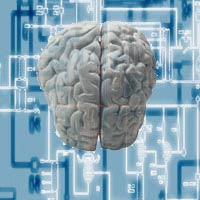Public release date: 16-Oct-2002 Back to Eurekalert
Contact: Claire Bowles
claire.bowles@rbi.co.uk
44-207-331-2751
New Scientist
Brain on a chip
ZOMBIE brains could soon become a powerful tool for drug developers. A biotech company has developed a way to keep slices of living brain tissue alive for weeks, allowing researchers to study the effect of chemicals on entire neural networks, not just individual cells.
"We are building stripped-down mini-brains, if you will, directly on a chip," says Miro Pastrnak, business development director of Tensor Biosciences of Irvine, California. He says the "brain-on-a-chip" could help drugs developers find better treatments for a host of neurological and psychiatric disorders, from Alzheimer's disease to schizophrenia. Tensor may already have found a more effective treatment for anxiety this way.
"Behaviour is the result of the electrical activity of billions of brain cells connected in complex circuits, not the activity of a cell or a receptor acting in isolation," says Pastrnak. And psychoactive drugs alter behaviour at this level, often affecting many different types of neural receptors, cell types and synapses. Yet at the moment, candidate drugs are only tested on individual nerve cells, because it's proved difficult to keep larger pieces of brain tissue alive for more than a few hours.
The mini-brain, however, survives for weeks at a time. "We can even co-culture tissues from different parts of the brain on the same chip to examine the communication between them," says Pastrnak.
It consists of a glass chip containing tens of thousands of interconnected living brain cells, taken from rats or mice and suspended in a solution of artificial cerebral fluid. An array of 64 electrodes on the chip's surface monitors the overall electrical activity of the brain tissue, just like an electroencephalogram (EEG), to show the effect that drugs have on the tissue.
Tensor's electrodes maintain continuous contact with the cells but do not damage them. This is vital when repeating experiments, because you have to be sure you are always getting readings from the same groups of neurons.
Neurophysicist Peter Fromherz of the Max Planck Institute for Biochemistry in Martinsried, Germany, who has developed techniques to grow neurons on silicon, says the chips would be even more useful if they could record the activity of individual neurons. "The problem is that these electrodes are widely spaced, so you get little information about the neural circuits," he says.
But the 64 electrodes are enough to get useful EEG readings even if you can't tap into the electrical activity of single neurons, Fromherz says. And Tensor has also developed a way to produce the natural EEG rhythms, or brainwaves, in its chip. The rhythms continue even after the chemical that induces them has been washed off. Fromherz thinks that the chip will indeed provide a powerful new tool for testing the effect of drugs.
At next week's Chips to Hits conference in Philadelphia, Tensor Biosciences will announce that it has already used its chip to find a potential drug for anxiety that it believes will be more specific, less toxic and have fewer side effects than existing drugs.
###
New Scientist issue: 19th October 2002
PLEASE MENTION NEW SCIENTIST AS THE SOURCE OF THIS STORY AND, IF PUBLISHING ONLINE, PLEASE CARRY A HYPERLINK TO: http://www.newscientist.com
"These articles are posted on this site to give advance access to other authorised media who may wish to quote extracts as part of fair dealing with this copyrighted material. Full attribution is required, and if publishing online a link to www.newscientist.com is also required. Advance permission is required before any and every reproduction of each article in full - please contact angela.bourton@rbi.co.uk. Please note that all material is copyright of Reed Business Information Limited and we reserve the right to take such action as we consider appropriate to protect such copyright."
UK CONTACT - Claire Bowles, New Scientist Press Office, London:
Tel: +44(0)20 7331 2751 or email claire.bowles@rbi.co.uk
US CONTACT - Michelle Soucy, New Scientist Boston Office:
Tel: +1 617 558 4939 or email michelle.soucy@newscientist.com
Written by Duncan Graham-Rowe















































